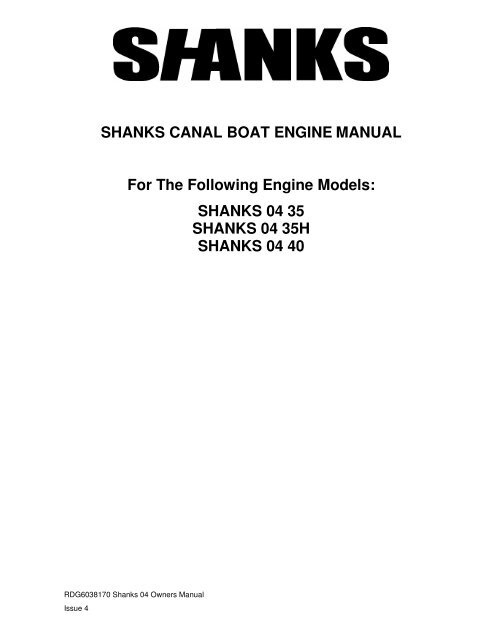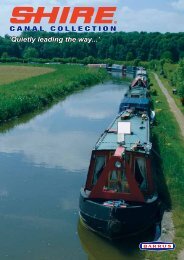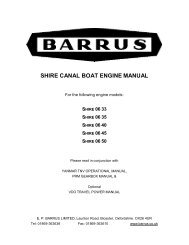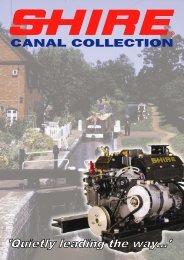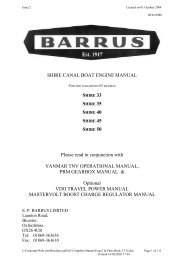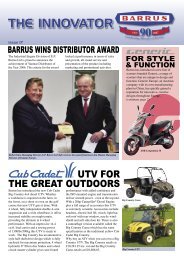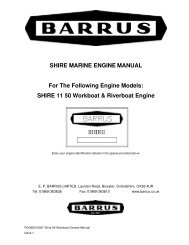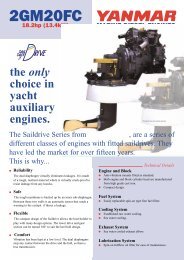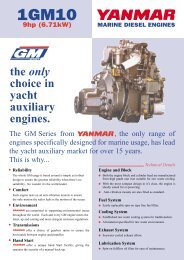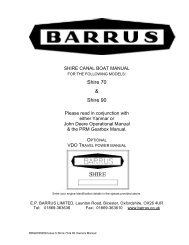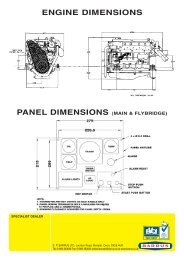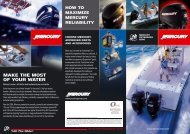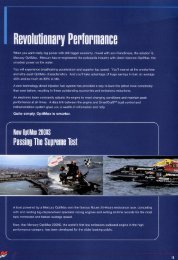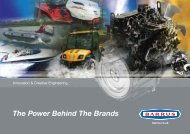Shanks Owners Manual (04 Build) 35, 35H & 40 (PDF) - EP Barrus
Shanks Owners Manual (04 Build) 35, 35H & 40 (PDF) - EP Barrus
Shanks Owners Manual (04 Build) 35, 35H & 40 (PDF) - EP Barrus
You also want an ePaper? Increase the reach of your titles
YUMPU automatically turns print PDFs into web optimized ePapers that Google loves.
SHANKS CANAL BOAT ENGINE MANUAL<br />
For The Following Engine Models:<br />
SHANKS <strong>04</strong> <strong>35</strong><br />
SHANKS <strong>04</strong> <strong>35</strong>H<br />
SHANKS <strong>04</strong> <strong>40</strong><br />
RDG6038170 <strong>Shanks</strong> <strong>04</strong> <strong>Owners</strong> <strong>Manual</strong><br />
Issue 4
Index<br />
SECTION 1- Safety Precautions ........................................................................................ 6<br />
1. General............................................................................................................................................. 6<br />
2. Lifting................................................................................................................................................ 6<br />
3. Rotating Shafts and Belts................................................................................................................. 6<br />
4. Exhaust System ............................................................................................................................... 6<br />
5. Launching and Lifting Boats............................................................................................................. 6<br />
6. Batteries ........................................................................................................................................... 7<br />
SECTION 2 - Engine Identification..................................................................................... 8<br />
SECTION 3 - Installation..................................................................................................... 9<br />
1. Ventilation......................................................................................................................................... 9<br />
2. Engine Beds ..................................................................................................................................... 9<br />
3. Cooling System ................................................................................................................................ 9<br />
4. Skin Tanks........................................................................................................................................ 9<br />
5. Pressurised Water Header Tank.................................................................................................... 10<br />
6. Shaft Connection............................................................................................................................ 10<br />
7. Engine Anti-Vibration Mounts......................................................................................................... 10<br />
8. Engine Mount Installation............................................................................................................... 11<br />
9. Engine Alignment ........................................................................................................................... 13<br />
10. Electrics.......................................................................................................................................... 13<br />
11. Engine Oil....................................................................................................................................... 14<br />
12. Fuel................................................................................................................................................. 14<br />
13. Coolant ........................................................................................................................................... 14<br />
14. Calorifier ......................................................................................................................................... 16<br />
15. Control Cables................................................................................................................................ 16<br />
16. Domestic Battery Bank................................................................................................................... 16<br />
SECTION 4 - Operation..................................................................................................... 17<br />
1. Starting The Engine For The First Time......................................................................................... 17<br />
2. Starting Procedure ......................................................................................................................... 17<br />
3. Stopping Procedure........................................................................................................................ 18<br />
4. Full Load Running .......................................................................................................................... 18<br />
5. Refuelling ....................................................................................................................................... 18<br />
6. Diesel Fuel Additive........................................................................................................................ 18<br />
7. Twin Thermostats........................................................................................................................... 18<br />
SECTION 5- Service Procedure ....................................................................................... 21<br />
1. Engine Oil and Filter Change ......................................................................................................... 21<br />
2. Air Filter Check & Change.............................................................................................................. 21<br />
3. Gearbox Oil Change....................................................................................................................... 22<br />
4. Primary Fuel Filter Water Drain...................................................................................................... 24<br />
5. Primary Fuel Filter Change ............................................................................................................ 24<br />
RDG6038170 <strong>Shanks</strong> <strong>04</strong> <strong>Owners</strong> <strong>Manual</strong><br />
Issue 4 Page 2 of 45
6. Secondary Fuel Filter Change ....................................................................................................... 25<br />
7. Bleeding the Fuel System. ............................................................................................................. 25<br />
8. Cooling System .............................................................................................................................. 26<br />
9. Belt Adjustment .............................................................................................................................. 27<br />
10. Belt Maintenance............................................................................................................................ 27<br />
11. Belt Replacement ........................................................................................................................... 27<br />
12. Standard Panel Maintenance......................................................................................................... 28<br />
13. Deluxe Panel Maintenance (if fitted) .............................................................................................. 28<br />
14. Checking Injection Pump Oil .......................................................................................................... 29<br />
15. Gearbox Hydraulic Oil Filter ........................................................................................................... 30<br />
16. Valve Clearance Adjustment.......................................................................................................... 32<br />
SECTION 6 <strong>Shanks</strong> Service Parts ................................................................................... 34<br />
SECTION 7- Service Schedule ......................................................................................... <strong>35</strong><br />
Specifications and Capacities .................................................................................................................. <strong>35</strong><br />
Service Intervals....................................................................................................................................... 36<br />
SECTION 8 - Packing List................................................................................................. 37<br />
SECTION 9 - <strong>Shanks</strong> Engine Specification..................................................................... 38<br />
Cylinder Head Tightening Pattern ............................................................................................................ 39<br />
SECTION 10 Wiring Diagrams ......................................................................................... <strong>40</strong><br />
Harness Wiring Diagram .......................................................................................................................... <strong>40</strong><br />
Panel Wiring Diagram .............................................................................................................................. 41<br />
SECTION 11 General Arrangements ............................................................................... 42<br />
<strong>Shanks</strong><strong>04</strong> <strong>35</strong>............................................................................................................................................. 42<br />
<strong>Shanks</strong><strong>04</strong> <strong>35</strong>H.......................................................................................................................................... 43<br />
<strong>Shanks</strong><strong>04</strong> <strong>40</strong>............................................................................................................................................. 44<br />
RDG6038170 <strong>Shanks</strong> <strong>04</strong> <strong>Owners</strong> <strong>Manual</strong><br />
Issue 4 Page 3 of 45
Declaration of Conformity for Recreational Craft Propulsion Engine<br />
with the requirements of Directive 94/25/EC as amended by<br />
2003/44/EC.<br />
Name of Engine Manufacturer: E.P.<strong>Barrus</strong> Ltd<br />
Address: E.P.<strong>Barrus</strong> LTD, Launton Road, Bicester, Oxon, OX26 4UR, England<br />
Name of Authorised Representative: E.P.<strong>Barrus</strong> Ltd<br />
Address: E.P.<strong>Barrus</strong> Ltd, Launton Road, Bicester, Oxon, OX26 4UR, England<br />
Engine type approved according to: Stage II of Directive 97/68/EC, 88/77/EC<br />
Description of Engine(s) and Essential Requirements<br />
Engine Type: Inboard Engine Fuel Type: Diesel Combustion Cycle: 4 Stroke<br />
Identification of Engine(s) covered by this Declaration of Conformity<br />
Engine Model Engine Type Engine Family code Type Approval Certificate Number<br />
<strong>Shanks</strong> 03 <strong>35</strong> LL480QEB 480 e11*97/68ka*20<strong>04</strong>/26*0557*00<br />
<strong>Shanks</strong> 03 <strong>35</strong>H LL480QEB 480 e11*97/68ka*20<strong>04</strong>/26*0557*00<br />
<strong>Shanks</strong> 03 <strong>40</strong> LL480QE 480 e11*97/68ka*20<strong>04</strong>/26*0557*00<br />
Essential Requirements<br />
Annex 1.B- Exhaust Emissions<br />
Standards<br />
Other normative<br />
document/method.<br />
Technical<br />
file<br />
B.1 Engine Identification <br />
B.2 Exhaust emission<br />
requirements<br />
Specify in more detail<br />
*= Mandatory standard.<br />
* * EN ISO 8178- 1:1996<br />
B.3 Durability <br />
B.4 <strong>Owners</strong> <strong>Manual</strong> <br />
Annex 1. C- Noise Emissions<br />
See Declaration of Conformity of the craft in which the engine(s) has(have)<br />
been installed<br />
This declaration of conformity is issued under the sole responsibility of the manufacturer. I declare on behalf of<br />
the engine manufacturer that the engine(s) [is (are) in conformity with the type(s) for which above mentioned<br />
EC type-examination or type approval certificate(s) has (have) been issued and] 1<br />
will meet the exhaust<br />
emission requirements of Directive 94/25/EC as amended by Directive 2003/44/EC when installed in a<br />
recreational craft, in accordance with the engine manufacturer’s supplied instructions and that this (these)<br />
engine(s) must not be put into service until the recreational craft which it is (they are) to be installed has been<br />
declared in conformity with the relevant provisions of the above mentioned Directives.<br />
Tim Hart<br />
General Manager, Marine Division<br />
Signed: Bicester, UK<br />
RDG6038170 <strong>Shanks</strong> <strong>04</strong> <strong>Owners</strong> <strong>Manual</strong><br />
Issue 4 Page 4 of 45
PLEASE NOTE:<br />
This manual has been compiled to help you to operate your engine and its associated parts<br />
with safety and pleasure. Please read it carefully and familiarise yourself with the engine<br />
and its parts before operation.<br />
To ensure that you have been registered for the engine warranty, please ask your Boat-<br />
<strong>Build</strong>er or Engine supplier to provide your portion of the registration document.<br />
The warranty period on all parts and labour is 12 months in a commercial application and 24<br />
months for a leisure application.<br />
Engine electrical systems fitted with alternator boost charge systems or any other electrical<br />
management systems other than those approved by <strong>Barrus</strong> are not covered by warranty.<br />
Engine alternator, starter motor and electrical components are only covered by 12months<br />
warranty.<br />
It is your responsibility to fill in the delivery report enclosed with this document to qualify for<br />
the full engine warranty. E.P.<strong>Barrus</strong> reserve the right to reject warranty claims if this is not<br />
completed. Failure to use recognised dealers or marine engineers, approved <strong>Shanks</strong> parts<br />
or to maintain the recommended service schedule will invalidate your warranty.<br />
E.P.<strong>Barrus</strong> reserves the right to change the specification of its products and manuals without<br />
prior notice.<br />
Depending upon the equipment specification of the engine and accessories fitted, there may<br />
be discrepancies with the information presented in this handbook. No claims may be<br />
pursued in this respect.<br />
WARNING:<br />
THIS MANUAL FORMS AN INTEGRAL PART OF THE ENGINE IT ACCOMPANIES, IF A<br />
TRANSFER OF TITLE OCCURS, IT MUST ALWAYS BE HANDED OVER TO THE NEW<br />
OWNER.<br />
RDG6038170 <strong>Shanks</strong> <strong>04</strong> <strong>Owners</strong> <strong>Manual</strong><br />
Issue 4 Page 5 of 45
SECTION 1- Safety Precautions<br />
1. General<br />
It is the responsibility of the installer/operator to ensure that the finished installation<br />
complies with the relevant health & safety requirements and the recreational craft<br />
directive before commissioning.<br />
Ensure that the engine battery isolator switch is in the off position and the key removed<br />
from the control panel before carrying out any maintenance or repairs.<br />
2. Lifting<br />
The lifting points supplied with the engine are for lifting the engine/gearbox only. A<br />
suitable spreader bar must be employed to prevent over-stressing either bracket during<br />
any lift.<br />
3. Rotating Shafts and Belts<br />
The engine and its accessories are not to be put into operation until they are integrated<br />
into the boat as a whole. No person should be in the engine compartment whilst the<br />
engine is running.<br />
4. Exhaust System<br />
Exhaust gases may have temperatures as high as 600 o C and contain elements which<br />
are harmful if ingested.<br />
It is therefore essential that exhaust systems are gas tight and lagged to prevent<br />
accidental burning.<br />
5. Launching and Lifting Boats<br />
Care must be taken when launching or craning new boats into or out of the waterway, so<br />
that water does not enter the engine via the exhaust system or air vents. It is<br />
recommended that these are blocked temporarily whilst undertaking this procedure.<br />
RDG6038170 <strong>Shanks</strong> <strong>04</strong> <strong>Owners</strong> <strong>Manual</strong><br />
Issue 4 Page 6 of 45
6. Batteries<br />
WARNING:<br />
EXPLOSIVE GASES / SULPHURIC ACID<br />
• Batteries can produce explosive gas, keep sparks and flames away from the battery.<br />
NO SMOKING<br />
• Batteries contain sulphuric acid; if splashed on skin or eyes, flush well with water and<br />
seek medical advice.<br />
• Keep the battery tops and battery compartment ventilated at all times.<br />
• If disconnecting the battery; remove the earth lead FIRST; and re-connect it last.<br />
• If charging the battery; ensure that the charger is switched off before connecting and<br />
disconnecting<br />
• Do not tip the battery on its side.<br />
• Please see label on battery or manufacturers instructions for specific information.<br />
RDG6038170 <strong>Shanks</strong> <strong>04</strong> <strong>Owners</strong> <strong>Manual</strong><br />
Issue 4 Page 7 of 45
SECTION 2 - Engine Identification<br />
Please quote the engine identification number during any enquiry or when ordering spare<br />
parts.<br />
This can be found engraved into the brass plate on top of the engine rocker cover and<br />
stamped to the crankcase next to the starter motor.<br />
An example of the engine identification plate is shown below:<br />
<strong>Build</strong> No<br />
BS Issue No<br />
Model<br />
<strong>04</strong> <strong>35</strong>E<br />
Iss<br />
01<br />
Serial No<br />
072000<br />
Model No<br />
3.5 travel power<br />
only (opt)<br />
Note: There are a number of optional extra’s that may be fitted to an engine for a particular<br />
customer that are not listed here.<br />
A list of common item service part numbers can be found in <strong>Shanks</strong> service parts in Section<br />
5.<br />
RDG6038170 <strong>Shanks</strong> <strong>04</strong> <strong>Owners</strong> <strong>Manual</strong><br />
Issue 4 Page 8 of 45
SECTION 3 - Installation<br />
1. Ventilation<br />
• All internal combustion engines radiate heat and require cool, clean air to aid<br />
complete combustion.<br />
• Please ensure that adequate engine room ventilation is provided, by fitting at least<br />
two vents of an aperture of not less than 10,000 mm 2 each, (16 in 2 ).<br />
An allowance must be made for any grills or louvers or bends placed in the airflows<br />
and generally an increase of 25% in area is sufficient to overcome any restriction<br />
problems.<br />
2. Engine Beds<br />
• These should be a minimum of 10mm thick, extended rearward and be welded to the<br />
hull and forward to the bulkhead. Webs or gussets must be welded in place midway to<br />
prevent flexing.<br />
3. Cooling System<br />
• Ensure pipe work to and from the skin tanks is of sufficient bore. A minimum of<br />
32mm (1 1 / 4 ") is recommended. Ensure tight bends and elbows are avoided or kept to<br />
a minimum.<br />
4. Skin Tanks<br />
• The ideal skin tank internal thickness is between 50 and 75mm, the table below will<br />
indicate a suitable tank size. However, volume will not compensate for lack of surface<br />
area. It should be recognised that fitting a large calorifier will increase the theoretical<br />
cooling capacity only until it is up to temperature. It is unlikely that a boat on the<br />
inland waterways will operate at full power for long periods of time. The engine<br />
cooling water outlets are on the left hand (port) side of the engine.<br />
RDG6038170 <strong>Shanks</strong> <strong>04</strong> <strong>Owners</strong> <strong>Manual</strong><br />
Issue 4 Page 9 of 45
Air Bleed Points<br />
Coolant from<br />
Engine<br />
Height<br />
Coolant to<br />
Engine<br />
Length<br />
Recommended Skin Tank Size<br />
Engine HP KW Skin tank Surface<br />
area m 2<br />
Suggested<br />
Height mm<br />
Suggested Length<br />
mm<br />
<strong>35</strong> <strong>35</strong> 26 1.0 721 1442<br />
<strong>40</strong> <strong>40</strong> 30 1.125 750 1500<br />
5. Pressurised Water Header Tank<br />
• The pressurised header tank should be mounted higher than the level of the engine<br />
and no more than 1 metre from the engine, to prevent cooling system air locks.<br />
6. Shaft Connection<br />
• Some type of flexible coupling must be used to connect the gearbox output flange to<br />
the propeller shaft flange.<br />
7. Engine Anti-Vibration Mounts<br />
• Ensure that the engine feet do not end up at the top of the thread on the engine<br />
mounts, this puts undue pressure on them and can result in excessive engine<br />
movement and premature mount failure. If this is a problem put steel packing plates<br />
under the mounts. Packing plates 25mm thick are available: order RDG3906 Engine<br />
mount spacer. Alternatively they can be manufactured locally.<br />
• Ensure that the engine has been installed for at least 24 hours before shaft alignment<br />
is checked, to allow the mounts time to settle under the engine weight.<br />
• Ensure that the anti-vibration mount centre screw is sufficiently raised so as not to<br />
touch the engine bed. If this occurs, excessive engine vibration will be experienced<br />
through the hull.<br />
RDG6038170 <strong>Shanks</strong> <strong>04</strong> <strong>Owners</strong> <strong>Manual</strong><br />
Issue 4 Page 10 of 45
• For best results, fit the front anti-vibration mounts into the front holes in the engine<br />
rails. If engine room space is a problem the mounts can be fitted slightly further back<br />
in the alterative holes, and the front of the rail cut off – leaving 50mm of material to<br />
retain strength (measuring from the centre of the mount hole to the front end of the<br />
rail)<br />
8. Engine Mount Installation<br />
• Care should taken to install mounts parallel to the engine rails with the washer and<br />
locknut firmly tightened on the cover of the mount. The maximum distance from the<br />
top of the locknut to the base of the adjusting nut must not exceed 5mm; any greater<br />
adjustment should be made using shims.<br />
RDG6038170 <strong>Shanks</strong> <strong>04</strong> <strong>Owners</strong> <strong>Manual</strong><br />
Issue 4 Page 11 of 45
RDG6038170 <strong>Shanks</strong> <strong>04</strong> <strong>Owners</strong> <strong>Manual</strong><br />
Issue 4 Page 12 of 45
9. Engine Alignment<br />
• The gearbox output shaft flange and propeller shaft input flange must be almost<br />
perfectly aligned. A maximum of ± 0.05mm (0.002") misalignment in any plane is<br />
acceptable. Ensure alignment is rechecked after the first 4 hours of running, after the<br />
first month, and thereafter annually.<br />
• If the engine is out of alignment it will result in excessive vibration and possible<br />
damage to the stern tube and propeller shaft.<br />
• Boats that are fitted with fully flexible drive couplings should still have the engine and<br />
shaft alignment as close as possible. A dummy shaft may be required for this<br />
purpose. (Note: some types of flexible shaft couplings require the input and output to<br />
be misaligned, check with the coupling manufacturer’s installation instructions).<br />
10. Electrics<br />
WARNING:<br />
DO NOT RUN THE ENGINE WITHOUT THE BLUE WIRE IN PLACE IF THE DOMESTIC<br />
BATTERIES ARE NOT CONNECTED OR ALTERNATOR DAMAGE WILL OCCUR.<br />
• Do not attach any part, hose or cable to the engine wiring harness. There is a<br />
warning label attached to the harness to remind you of this.<br />
• Connect the wiring extension harness multi plug to the panel plug, and the other end<br />
to the engine. Connect the single wire that is adjacent to the 11 pin plug<br />
• Connect the start battery positive cable to the engine starter motor solenoid terminal.<br />
• The starter motor battery cable must have a cross sectional area of at least 50mm 2 .<br />
• For twin alternator engines, connect the domestic battery positive cable to the 110A<br />
alternator B+ terminal (see wiring diagram). This ensures that the <strong>40</strong>A alternator<br />
charges the start battery and the 110A (or 160A) alternator charges the domestic<br />
battery, removing the requirement for a split charging system or relay.<br />
• The blue link wire between the 110A Alternator B+ terminal or 160A “pos out” terminal<br />
and the starter motor solenoid must be removed when the domestic battery positive<br />
lead is connected to the terminal post.<br />
• A cable will need to be manufactured locally and fitted between the lower 110A or<br />
160A alternator B+/ “pos out” terminal and domestic battery positive terminal. Cable<br />
should have a minimum cross sectional area of <strong>35</strong>mm 2 (175 A)<br />
RDG6038170 <strong>Shanks</strong> <strong>04</strong> <strong>Owners</strong> <strong>Manual</strong><br />
Issue 4 Page 13 of 45
• Both negative battery terminals can be connected to a common earth point.<br />
11. Engine Oil<br />
• All <strong>Shanks</strong> engines are supplied fully run in.<br />
• Check oil levels in engine and gearbox before starting.<br />
12. Fuel<br />
• Ensure the main fuel tank is clear of dirt & water.<br />
• A separate water trap is strongly advised.<br />
• Connect fuel feed and return hoses from engine to main supply and return lines to<br />
main fuel tank, ensuring they are connected the correct way around. The hose to the<br />
fuel lift pump is the inlet.<br />
• The engine hoses are supplied with 5 / 16 " (8mm) OD metal hose tails, and should be<br />
securely fitted to the main supply and return pipes with compression fittings.<br />
• The engine hoses should have sufficient slack to absorb engine movement without<br />
placing strain on the hoses, and be securely clipped to prevent accidental damage<br />
and chafing.<br />
• Initially fill the fuel system by unscrewing the lift pump plunger rod on the injection<br />
pump lift pump (see Error! Reference source not found. page Error! Bookmark<br />
not defined.). Loosen the bleed screw on the top of the primary fuel filter/water trap,<br />
pump the lift pump and close when fuel begins to flow clearly (no bubbles). It is rarely<br />
necessary to bleed the injection pump or injectors upon installation as the engine will<br />
already have fuel in it from the engine run in and test procedure.<br />
13. Coolant<br />
• Prepare coolant mix of 60% clean tap water and <strong>40</strong>% antifreeze.<br />
• Open the calorifier taps (if fitted) to fill the calorifier system and displace air.<br />
• To fill the cooling system for the first time, fill the skin tank via the inlet hose<br />
connection or filler plug if fitted. Then fill the engine via the header tank, ensure that<br />
the filler hose tap is open. Start and run the engine for several minutes to dispel any<br />
remaining air bubbles, close tap only when all the air is dispelled. This tap is normally<br />
closed at other times.<br />
• N.B. After running the engine for the first time, monitor the water level frequently as<br />
trapped air bubbles may be expelled. Top up the system as necessary.<br />
RDG6038170 <strong>Shanks</strong> <strong>04</strong> <strong>Owners</strong> <strong>Manual</strong><br />
Issue 4 Page 14 of 45
<strong>Shanks</strong> <strong>35</strong> & <strong>40</strong><br />
Engine filler<br />
tap closed<br />
Calorifier<br />
outlet tap open<br />
<strong>Shanks</strong> <strong>35</strong>H<br />
Calorifier outlet<br />
Header tank<br />
connections<br />
Air bleed connection<br />
(small hole in water bottle)<br />
Engine filler<br />
(large hole in<br />
water bottle)<br />
RDG6038170 <strong>Shanks</strong> <strong>04</strong> <strong>Owners</strong> <strong>Manual</strong><br />
Issue 4 Page 15 of 45
14. Calorifier<br />
• The temperature of coolant flowing to the calorifier from the engine can be 85 – 90°C.<br />
A blender valve must be incorporated in the calorifier/hot water system outlet to lower<br />
the hot water temperature for domestic use.<br />
15. Control Cables<br />
• Connect engine speed control cable. With the engine off, ensure that the engine<br />
speed control lever achieves full travel from idle to full speed. Adjust if necessary.<br />
• Check the gearbox shift lever selects positively and that the drive direction<br />
corresponds with the gearshift control lever. Ensure that the gearbox control lever<br />
and the gearshift lever are both in neutral before connection. Adjust if necessary.<br />
16. Domestic Battery Bank<br />
Domestic battery banks that are too large create excessive loads on the domestic<br />
alternator. Alternators running at maximum output for prolonged periods of time will<br />
eventually fail; alternators that fail due to the battery bank being over the maximum<br />
recommended size will not be covered by warranty.<br />
Higher output alternators or travelpower kits are available; if larger battery banks are<br />
required discuss your individual power requirements with the boat builder.<br />
• The maximum domestic battery bank is calculated using the following:<br />
Live aboard, three times domestic alternator’s maximum output current.<br />
Hire fleet use, three and a half times domestic alternator, maximum output current.<br />
If the engine is fitted with a <strong>Barrus</strong> approved alternator management system the<br />
domestic battery bank can be up to four times the domestic alternator, maximum<br />
output current.<br />
Example:<br />
Hire fleet application fitted with 110 amp domestic charge alternator<br />
3.5 x 110 = 385 ampere/hour maximum domestic battery bank size.<br />
RDG6038170 <strong>Shanks</strong> <strong>04</strong> <strong>Owners</strong> <strong>Manual</strong><br />
Issue 4 Page 16 of 45
SECTION 4 - Operation<br />
1. Starting The Engine For The First Time<br />
• Remove ignition key.<br />
• Ensure all oil and coolant levels are checked.<br />
• Ensure both engine and domestic batteries are connected or the blue link wire is in<br />
place. Battery master switches must be turned on.<br />
• Check all connections and mountings are tight.<br />
• Ensure the red protection cap is removed from the air filter inlet.<br />
2. Starting Procedure<br />
• Ensure the gearshift control lever is set to neutral, and that persons are clear of any<br />
moving parts.<br />
• Insert the ignition key.<br />
• Turn key to first position, run.<br />
• Observe warning lights (and gauges on deluxe panel). NB the engine overheat light<br />
will only illuminate when the water temperature exceeds the safe level<br />
• Listen for warning buzzer.<br />
• Watch the glow plug light, when this goes out proceed to;<br />
• Turn key to second position, start, and hold to crank.<br />
• Crank the engine for no more than 15 seconds.<br />
• If the engine struggles to start, it may be required to apply up to 50% throttle to<br />
increase the fuelling during the initial cranking period.<br />
• On engine start, immediately release key.<br />
• Key will return to first position, run.<br />
The warning buzzer will stop and on the deluxe panel the oil pressure gauge will show<br />
an oil pressure of 3– 4 bar [45-60 psi].<br />
• Should any warning light not go out, or if there is no reading on the oil pressure<br />
gauge, the buzzer will continue sounding. In this case, stop the engine immediately<br />
and check the relevant system (Note: if the charge light does not go out, rev the<br />
engine briefly).<br />
• Stop engine immediately if any abnormal noises are detected.<br />
RDG6038170 <strong>Shanks</strong> <strong>04</strong> <strong>Owners</strong> <strong>Manual</strong><br />
Issue 4 Page 17 of 45
• Visually check the engine for oil, fuel and coolant leaks, (after initial start up and at<br />
regular intervals, N.B. engine must be stopped to carry out this check).<br />
3. Stopping Procedure<br />
• Move speed control lever to idle position.<br />
• Turn key to off position.<br />
4. Full Load Running<br />
• Running diesel engines near their rated output (maximum load) regularly will disperse<br />
accumulated carbon and condensation enhancing engine life and reducing emissions.<br />
• Running the engine at, or near, maximum speed whilst in gear may not be possible<br />
on inland waterways with speed limits in place. This will have to be carried out whilst<br />
moored up. Ensure that the mooring ropes and posts are strong enough to allow this,<br />
and that the water is deep enough not to damage the propeller. It is recommended<br />
that <strong>Shanks</strong> engines be run at or near full load for 15 minutes (maximum revs, in<br />
gear) every 50 hours.<br />
5. Refuelling<br />
• All <strong>Shanks</strong> canal boat engines run on Diesel fuel.<br />
• Please note that if the vessel is to be left for any period of time the fuel tank should be<br />
full to eliminate the build up of condensation and formation of water in the fuel tank.<br />
6. Diesel Fuel Additive<br />
The use of diesel fuel additive is strongly recommended on <strong>Shanks</strong> & Shire engines.<br />
The quality of the fuel available when cruising is often unknown; also the fuel may<br />
have been in storage for long periods of time. The use of additives will ensure that<br />
your engine fuel injection system is in top condition which should result in many years<br />
of smooth reliable operation without the cost and inconvenience of expensive<br />
breakdowns due to poor quality fuel. It has also been found that improvements in fuel<br />
consumption and startability are an added benefit of using this product.<br />
Diesel fuel additive is available from your <strong>Shanks</strong> or Shire dealer in a handy 470ml<br />
container, part number <strong>EP</strong>B5607.<br />
7. Twin Thermostats<br />
The twin thermostat design is a feature incorporated in to the <strong>Shanks</strong> canal boat<br />
RDG6038170 <strong>Shanks</strong> <strong>04</strong> <strong>Owners</strong> <strong>Manual</strong><br />
Issue 4 Page 18 of 45
engine range. It ensures that the engine warms up very quickly due to the first<br />
thermostat being closed so that cooling water is routed through around the engine<br />
block. This ensures efficient engine operations with reduced fuel consumption and<br />
even cleaner exhaust emissions. It also helps in keeping engine wear to a minimum.<br />
The diagrams on the following page show the operation of the cooling system.<br />
RDG6038170 <strong>Shanks</strong> <strong>04</strong> <strong>Owners</strong> <strong>Manual</strong><br />
Issue 4 Page 19 of 45
Filler<br />
Cap<br />
Air Vent to<br />
Header Tank.<br />
With the engine quickly up to<br />
operating temperature, the first 76°<br />
thermostat opens. The water now<br />
To Skin<br />
Tank<br />
Filler<br />
Cap<br />
To<br />
Calorifier<br />
88° Thermostat (Closed)<br />
76° Thermostat<br />
flows to the domestic hot water tank,<br />
Water Cooled<br />
Exhaust Manifold<br />
resulting in hot water being rapidly<br />
available.<br />
From<br />
Skin Tank<br />
From<br />
Calorifier<br />
Engine Block<br />
Then the water stored in the hot<br />
water tank has reached full<br />
Filler<br />
Cap<br />
Air Vent to<br />
Header Tank.<br />
temperature, the second 88°<br />
thermostat opens and water can<br />
then flow to the skin tank and<br />
To Skin<br />
Tank<br />
Filler<br />
Cap<br />
To<br />
Calorifier<br />
88° Thermostat (Closed)<br />
76° Thermostat<br />
correctly control engine cooling.<br />
Water Cooled<br />
Exhaust Manifold<br />
The exhaust manifold that earlier<br />
helped to heat engine water is now<br />
cooled to ensure safe operation and<br />
reduce engine compartment<br />
From<br />
Skin Tank<br />
From<br />
Calorifier<br />
Engine Block<br />
temperatures.<br />
Filler<br />
Cap<br />
Air Vent to<br />
Header Tank.<br />
If the load on the engine reduces<br />
and the demand for domestic hot<br />
water increases then the system will<br />
To Skin<br />
Tank<br />
Filler<br />
Cap<br />
To<br />
Calorifier<br />
88° Thermostat<br />
76° Thermostat<br />
automatically compensate and redirect<br />
water to ensure that a plentiful<br />
Water Cooled<br />
Exhaust Manifold<br />
supply of hot water is always<br />
available.<br />
From<br />
Skin Tank<br />
From<br />
Calorifier<br />
Engine Block<br />
RDG6038170 <strong>Shanks</strong> <strong>04</strong> <strong>Owners</strong> <strong>Manual</strong><br />
Issue 4 Page 20 of 45
SECTION 5- Service Procedure<br />
1. Engine Oil and Filter Change<br />
CAUTION:<br />
WEAR DISPOSABLE GLOVES AND BEWARE OF HOT OIL AND ENGINE BLOCK.<br />
REMOVE THE IGNITION KEY BEFORE WORKING IN ENGINE COMPARTMENT.<br />
• Change the engine oil while the engine is still hot.<br />
• Remove the blanking plug in the sump pump spout. [6mm Allen key] Note: <strong>Shanks</strong> <strong>40</strong><br />
has two oil drain pumps, the engine sump is the pump mounted adjacent to the starter<br />
motor.<br />
• Place a plastic tube over the spout and into a container. Operate the pump handle to<br />
empty the sump. (Remember to refit the blanking plug).<br />
• Place a drip tray under the engine to catch the small amount of oil that will escape<br />
from the oil filter. Using a strap type oil filter removal tool, slacken the filter from the<br />
engine block in an anti clockwise direction, remove the tool and spin off the filter.<br />
• Lightly oil the new filter O-ring seal and install the filter onto the engine. Spin it on in a<br />
clockwise direction and finally tighten by hand only as firmly as you can.<br />
• Refill the sump using the oil filler cap in the rocker cover on top of the engine.<br />
• Oil level should be to the top mark on the dipstick.<br />
• Run the engine for 5 minutes to fully circulate the oil, and check for leaks, stop the<br />
engine. Wait 5 minutes before checking the oil level with the dipstick and top up if<br />
required.<br />
• Do not overfill with oil above the maximum level marker as this may cause damage to<br />
the internal components of the engine.<br />
2. Air Filter Check & Change<br />
CAUTION:<br />
WEAR DISPOSABLE GLOVES AND BEWARE OF HOT ENGINE BLOCK.<br />
REMOVE THE IGNITION KEY BEFORE WORKING IN ENGINE COMPARTMENT.<br />
• Release the 2 spring clips, pull off the end cover to reveal the filter element. The<br />
RDG6038170 <strong>Shanks</strong> <strong>04</strong> <strong>Owners</strong> <strong>Manual</strong><br />
Issue 4 Page 21 of 45
element simply pulls out.<br />
• The air filters elements are constructed of pleated paper and requires regular<br />
inspection for dirt or dust. Air filter elements cannot be cleaned and must be replaced.<br />
The engine requires an unrestricted flow of clean air to run efficiently. Increased<br />
levels of smoke and high fuel consumption and eventually engine damage will occur if<br />
the air filter is not maintained.<br />
• To fit the new element, slide the open end of the filter element into the main body;<br />
gently push the element home until fully seated. Refit the end cover.<br />
3. Gearbox Oil Change<br />
CAUTION:<br />
WEAR DISPOSABLE GLOVES AND BEWARE OF HOT OIL AND GEARBOX CASINGS.<br />
REMOVE THE IGNITION KEY BEFORE WORKING IN ENGINE COMPARTMENT.<br />
PRM 120 manual Gearbox<br />
• Change the gearbox oil while it is still hot.<br />
• Place a tray beneath the gearbox that will hold at least 3.0 litres.<br />
• Undo the gearbox drain plug, and remove, allow the oil to drain fully. The drain plug is<br />
magnetic remove any debris on it.<br />
• Replace the drain plug, ensure that the sealing washer (if used) is still in place, and in<br />
good condition, tighten. Fit a new washer if required.<br />
• Refill the gearbox with oil to the upper mark on the dipstick. Screw dipstick in fully to<br />
establish level.<br />
• Do not overfill gearbox as this can damage the internal components.<br />
MA 100A 2:1 Hydraulic Gearbox<br />
• This gearbox does not have a drain pump<br />
• Change the gearbox oil while it is still hot.<br />
• Place a tray beneath the gearbox that will hold at least 3.0 litres.<br />
• Undo the gearbox drain plug, and remove, allow the oil to drain fully. The drain plug is<br />
magnetic remove any debris on it.<br />
• Replace the drain plug, ensure that the sealing washer (if used) is still in place, and in<br />
RDG6038170 <strong>Shanks</strong> <strong>04</strong> <strong>Owners</strong> <strong>Manual</strong><br />
Issue 4 Page 22 of 45
good condition, tighten. Fit a new washer if required.<br />
• Refill the gearbox with oil to the upper mark on the dipstick. Screw dipstick in fully to<br />
establish level.<br />
• Do not overfill gearbox as this can damage the internal components.<br />
MA 125A 2.5:1 Hydraulic Gearbox<br />
• This gearbox has a drain pump<br />
• Remove the bolt from the end of the pump outlet<br />
• Either fit a piece of hose to the pump outlet or put a drip tray under the outlet & pump<br />
the oil out of the gearbox.<br />
• Place a drip tray under the magnetic drain plug; (Error! Reference source not<br />
found. page Error! Bookmark not defined.) and remove the plug; clean any debris.<br />
Check the sealing washer is in good condition, replace and tighten the magnetic plug.<br />
On later model engines the plug moves towards the centre of the gearbox is painted<br />
yellow and removed with an Allen key<br />
• Remove the dipstick and refill the gearbox through the dipstick hole with engine oil up<br />
to the top mark on the dipstick.<br />
• Run and check for leaks and oil level<br />
Magnetic drain plug<br />
MA125A Magnetic Drain Plug<br />
Disposal of Oil and Related Items<br />
• Please dispose of used oil and oil filters safely with due regard for the environment,<br />
and take to your local waste oil disposal point.<br />
RDG6038170 <strong>Shanks</strong> <strong>04</strong> <strong>Owners</strong> <strong>Manual</strong><br />
Issue 4 Page 23 of 45
• Do not allow oil or contaminated parts to enter the inland waterway system.<br />
4. Primary Fuel Filter Water Drain<br />
CAUTION: WEAR DISPOSABLE GLOVES.<br />
REMOVE THE IGNITION KEY BEFORE WORKING IN ENGINE COMPARTMENT.<br />
• Place a small drain bowl under the primary fuel filter/water trap, or place a length of<br />
tube onto the drain nipple and run this into a suitable container.<br />
• Loosen the drain screw located in the bottom of the fuel filter/water trap.<br />
• Drain off any water (if any)<br />
• When water is drained off, close the drain screw.<br />
• It is unlikely the complete fuel system will require bleeding.<br />
• Run for 5 minutes.<br />
• Check that the drain union is tight and that there are no leaks.<br />
5. Primary Fuel Filter Change<br />
CAUTION: WEAR DISPOSABLE GLOVES.<br />
REMOVE THE IGNITION KEY BEFORE WORKING IN ENGINE COMPARTMENT.<br />
• Ensure the fuel tank is at least ¾ full before undertaking this procedure<br />
• Turn off the main boat fuel supply tap, located on or near the fuel tank.<br />
• Place a small drip tray under the filter body.<br />
• Undo the centre bolt [11mm spanner] and remove.<br />
• Pull out the bowl; the filter element pulls down from the top cover.<br />
• Remove and renew all of the O-ring seals that are supplied with the new filter<br />
element.<br />
• Push the new element up into the top cover, refit the bowl, position so that the drain<br />
screw is accessible and refit the centre bolt.<br />
• Ensure all the parts are aligned correctly and tighten the centre bolt.<br />
• Re-fit new filter and tighten by hand.<br />
RDG6038170 <strong>Shanks</strong> <strong>04</strong> <strong>Owners</strong> <strong>Manual</strong><br />
Issue 4 Page 24 of 45
• Turn the main boat fuel supply back on.<br />
• Ensure system is correctly bled before attempting start up.<br />
6. Secondary Fuel Filter Change<br />
CAUTION: WEAR DISPOSABLE GLOVES.<br />
REMOVE THE IGNITION KEY BEFORE WORKING IN ENGINE COMPARTMENT.<br />
• Ensure the fuel tank is at least ¾ full before undertaking this procedure<br />
• Turn off the main boat fuel supply tap, located on or near the fuel tank.<br />
• Place a small drip tray under filter assembly.<br />
• Use a filter wrench to unscrew the filter element.<br />
• Add a smear of engine oil to the new filter rubber seal.<br />
• Re-fit new filter and tighten by hand.<br />
• Turn the main boat fuel supply back on.<br />
• Ensure system is correctly bled before attempting start up.<br />
Primary filter<br />
Secondary<br />
filter<br />
7. Bleeding the Fuel System.<br />
CAUTION: WEAR DISPOSABLE GLOVES.<br />
REMOVE THE IGNITION KEY BEFORE WORKING IN ENGINE COMPARTMENT.<br />
• Ensure that the fuel tank is at least ¾ full prior to undertaking this task.<br />
RDG6038170 <strong>Shanks</strong> <strong>04</strong> <strong>Owners</strong> <strong>Manual</strong><br />
Issue 4 Page 25 of 45
• Unscrew the lift pump plunger rod on the fuel injection pump (see Error! Reference<br />
source not found. page Error! Bookmark not defined.)<br />
• Loosen the bleed screw on top of the primary fuel filter / water trap, pump the lift<br />
pump and close when fuel flows freely (no bubbles). It is rarely necessary to bleed the<br />
fuel injection pump and injectors after changing a fuel filter.<br />
• If the engine does run out of fuel the pump and injectors will need bleeding.<br />
• Slacken the fuel pump inlet connection and pump the lift pump until fuel appears<br />
tighten connection.<br />
• Slacken all of the injector’s inlet connections at the injector end, crank engine with the<br />
starter motor until fuel appears, stop cranking and re tighten connections.<br />
• Crank engine this time the engine should start; failure requires this procedure to be<br />
repeated.<br />
• Clean up any spilt fuel and dry engine, check for leaks.<br />
8. Cooling System<br />
CAUTION:<br />
DO NOT CHECK THE COOLANT LEVEL WHEN THE ENGINE IS HOT.<br />
REMOVE THE IGNITION KEY BEFORE WORKING IN ENGINE COMPARTMENT<br />
• To check the coolant level, ensure that the engine has been shut down for at least<br />
half an hour.<br />
• The coolant level can be checked visually and should between the two level marks<br />
moulded on the front of the white, plastic expansion tank.<br />
• If required, top up the level with coolant (60% clean tap water and <strong>40</strong>% ethylene<br />
glycol based anti-freeze) through the expansion tank filler cap.<br />
• Do not use water only to top up mix as this weakens the coolant mix, reducing the<br />
level of frost protection and anti-corrosion prevention of the coolant.<br />
RDG6038170 <strong>Shanks</strong> <strong>04</strong> <strong>Owners</strong> <strong>Manual</strong><br />
Issue 4 Page 26 of 45
9. Belt Adjustment<br />
CAUTION:<br />
REMOVE THE IGNITION KEY BEFORE WORKING IN ENGINE COMPARTMENT.<br />
• Depress the longest run of the drive belt to be checked. If the travel exceeds 15 –20<br />
mm using hard finger pressure, the belt needs re-tensioning.<br />
• Loosen the upper adjuster bolts on the alternator, and the lower mounting pivot nut<br />
and bolt, either pull out using hand pressure or use the tensioning screw, depending<br />
on which alternator belt is to be tensioned.<br />
• Pull the alternator away from the engine to tighten the belt.<br />
• Hold the alternator in position and re-tighten all the bolts.<br />
• Note: if the belts are over tightened alternator bearing failure will occur.<br />
10. Belt Maintenance<br />
• Do not allow oil to contact the belt. Oil attacks the construction of the belt, reduces<br />
the drive efficiency, and will ultimately cause, it to fail prematurely.<br />
• Replace the belt, if it cracks; splits or as the adjustment nears the limit of its travel.<br />
• Note: Some boat builders may remove one or more alternators during installation, it is<br />
important that alternator alignment is perfect or premature belt failure will occur.<br />
11. Belt Replacement<br />
CAUTION:<br />
REMOVE THE IGNITION KEY BEFORE WORKING IN ENGINE COMPARTMENT.<br />
• Ensure that you have the correct new belts prior to starting this procedure. Some<br />
customers will order engines with non standard optional alternators that will have<br />
different belts to the standard ones listed; in this case make a note of the belt sizes<br />
when the engine is delivered<br />
• Loosen the top adjuster bolts, and the lower mounting pivot nut and bolt.<br />
• Push the alternator towards the engine to loosen the belt.<br />
• Remove the belt.<br />
RDG6038170 <strong>Shanks</strong> <strong>04</strong> <strong>Owners</strong> <strong>Manual</strong><br />
Issue 4 Page 27 of 45
• Hold the belt in position over the top alternator pulley; rotate the engine, if required, by<br />
hand, to guide the new belt into the pulley “V”s check it is correctly seated in the<br />
pulley.<br />
• Re-tension the belt as above.<br />
12. Standard Panel Maintenance<br />
CAUTION: TURN BATTERY ISOLATION SWITCHES OFF<br />
REMOVE THE IGNITION KEY BEFORE WORKING IN ENGINE COMPARTMENT.<br />
Bulb replacement<br />
Release the panel from its mounting<br />
1. To replace a tacho meter illumination bulb.<br />
• The tacho bulb is accessible from the rear of the panel and is retained by a black<br />
plastic holder with a bayonet fitting. This can be gently removed by rotating with a pair<br />
of needle nose pliers.<br />
2. To replace a warning light bulb.<br />
• The warning light bulbs are accessible from the front of the panel.<br />
• Carefully prise out the coloured lens<br />
• With needle nose pliers, remove the clear lens to reveal the bulb<br />
• The capless bulb is a push fit in the holder<br />
13. Deluxe Panel Maintenance (if fitted)<br />
CAUTION:<br />
TURN BATTERY ISOLATION SWITCHES OFF<br />
REMOVE THE IGNITION KEY BEFORE WORKING IN ENGINE COMPARTMENT.<br />
1. Warning light bulb replacement<br />
2. To replace a Tachometer illumination bulb.<br />
a. Unscrew and pull out the instrument panel.<br />
b. The tacho bulb is accessible from the rear of the panel and is retained by a black<br />
plastic holder with a bayonet fitting.<br />
c. Removed by rotating half a turn with a pair of needle nose pliers.<br />
RDG6038170 <strong>Shanks</strong> <strong>04</strong> <strong>Owners</strong> <strong>Manual</strong><br />
Issue 4 Page 28 of 45
d. The cap less bulb is a push fit in the holder.<br />
3. To replace a Gauge illumination bulb.<br />
a. Unscrew and pull out the instrument panel.<br />
b. The illumination bulb holder is a push fit in the rear of the gauge.<br />
c. The cap less bulb is a push fit in the holder.<br />
4. To replace a Gauge warning light bulb.<br />
a. Unscrew and pull out the instrument panel.<br />
b. The warning light bulb holder is a push fit in the rear of the gauge, but is retained<br />
by a plastic clip. Gently push the clip to one side to release the holder.<br />
c. The cap less bulb is a push fit in the holder.<br />
d. Ensure that on refitting, the bulb holder is retained by the clip, you should confirm<br />
correct positioning when the clip “clicks” when locked.<br />
5. To replace a warning light bulb.<br />
• The warning light bulbs are accessible from the front of the panel.<br />
• Carefully prise out the coloured lens<br />
• With needle nose pliers, remove the clear lens to reveal the bulb<br />
The cap less bulb is a push fit in the holder<br />
14. Checking Injection Pump Oil<br />
CAUTION:<br />
REMOVE THE IGNITION KEY BEFORE WORKING IN THE ENGINE COMPARTMENT.<br />
• Check oil level on small dipstick adjacent to fuel injection pump.<br />
• Top up as necessary using engine oil from small oil can.<br />
RDG6038170 <strong>Shanks</strong> <strong>04</strong> <strong>Owners</strong> <strong>Manual</strong><br />
Issue 4 Page 29 of 45
Dipstick<br />
Lift pump plunger<br />
Fuel Injection Pump<br />
Drain screw<br />
15. Gearbox Hydraulic Oil Filter<br />
CAUTION:<br />
REMOVE THE IGNITION KEY BEFORE WORKING IN THE ENGINE COMPARTMENT.<br />
• Check gearbox oil weekly and at recommended service period remove filter and<br />
clean.<br />
• Drain gearbox oil; oil capacity of the MA125A gearbox is 4.8L and 2L for the MA100<br />
• The procedure is the same for both; remove the banjo bolt going into the filter and<br />
ease the adjacent banjo bolt (as shown below to allow access to the filter)<br />
• Remove filter; clean and replace ensuring the sealing washer is in good condition.<br />
• Refill gearbox with correct amount of 15W<strong>40</strong> CD grade oil.<br />
• Take care not to overfill gearbox as damage may occur to internal components.<br />
• Check filter head to ensure there are no leaks.<br />
RDG6038170 <strong>Shanks</strong> <strong>04</strong> <strong>Owners</strong> <strong>Manual</strong><br />
Issue 4 Page 30 of 45
Hydraulic gearbox filter<br />
Hydraulic gearbox oil filter<br />
Disposal of Oil and Related Items<br />
• Please dispose of used oil and oil filters safely with due regard for the environment,<br />
and take to your local waste oil disposal point. Do not allow oil or contaminated parts<br />
to enter the inland waterway system.<br />
RDG6038170 <strong>Shanks</strong> <strong>04</strong> <strong>Owners</strong> <strong>Manual</strong><br />
Issue 4 Page 31 of 45
16. Valve Clearance Adjustment.<br />
CAUTION:<br />
REMOVE THE IGNITION KEY BEFORE WORKING IN THE ENGINE COMPARTMENT.<br />
This is to be undertaken by an authorised Shire / Yanmar dealer or competent marine<br />
engineer.<br />
Valve clearance can affect the performance of the engine and should be inspected and, if<br />
necessary, adjusted after the first 500hrs and every 500hrs thereafter. The tools required<br />
for this procedure are feeler gauges, flat head screwdriver, 13mm ring spanner and a<br />
27mm socket to fit the front crank nut. Always turn the engine clockwise when viewed<br />
from the front of the engine. The valves are arranged outlet then inlet for each cylinder<br />
when observed from the front of the engine. No 1 valve is at the front of the engine (water<br />
pump end), No 8 valve is at the rear engine (flywheel end). The intake valve clearance is<br />
0.2-0.25mm and the exhaust valve clearance is 0.25-0.3mm. The procedure for checking<br />
clearances is as follows:<br />
a) Remove the engine rocker cover<br />
b) Rotate engine until the no 1 valve is fully compressed, (open).<br />
c) Then rotate the engine 360° so that the cam follower is on the back of the cam lobe.<br />
d) Check the valve clearance is with the acceptable range by using the feeler gauge. If it<br />
is, mark/note that the valve has been done and move on the next valve. If it is not,<br />
continue to part e).<br />
e) Loosen the nut with the 13mm spanner, and then loosen or tighten the adjusting<br />
screw. Place the feeler gauge under the rocker and turn the screw until the gauge<br />
begins to “grab” between the valve and the rocker.<br />
f) Once this has been achieved, remove the feeler gauge and, whilst holding the screw<br />
in place with the screwdriver, tighten the nut back up.<br />
g) Give the valve one final check to ensure clearance is satisfactory and mark/note that<br />
it has been done.<br />
h) Then repeat for the remaining valves no 2 next 3, 4, etc.<br />
i) After all the valves have been checked and adjusted replace the rocker cover. The<br />
gasket is a rubber type and can sometimes be re-used if a spare is not available.<br />
RDG6038170 <strong>Shanks</strong> <strong>04</strong> <strong>Owners</strong> <strong>Manual</strong><br />
Issue 4 Page 32 of 45
17. Oil Recovery Filter<br />
CAUTION:<br />
REMOVE THE IGNITION KEY BEFORE WORKING IN THE ENGINE COMPARTMENT.<br />
• Unscrew the oil recovery system cover.<br />
• Pull the internal up and remove the internal filter, dispose of carefully.<br />
• Refit<br />
Cover<br />
Filter<br />
RDG6038170 <strong>Shanks</strong> <strong>04</strong> <strong>Owners</strong> <strong>Manual</strong><br />
Issue 4 Page 33 of 45
SECTION 6 <strong>Shanks</strong> Service Parts<br />
Model<br />
Primary<br />
Fuel Filter<br />
Secondary Alternator belt<br />
Fuel Filter <strong>40</strong>A 110A<br />
Air Filter<br />
Element<br />
Oil<br />
Filter<br />
<strong>35</strong> RDG2238<br />
<strong>35</strong>H RDG2238<br />
<strong>40</strong> RDG2238<br />
GB12732-96 RDG0<strong>04</strong>7860 RDG5795<br />
GB12732-96 RDG0<strong>04</strong>7860 RDG5795<br />
GB12732-96 RDG0<strong>04</strong>7860 RDG5795<br />
KM385T-<br />
10501<br />
(CX0706)<br />
KM385T-<br />
10501<br />
(CX0706)<br />
KM385T-<br />
10501<br />
(CX0706)<br />
LL480-<br />
09305<br />
LL480-<br />
09305<br />
LL480-<br />
09305<br />
3.5kw VDO Electrolux Travel power alternator belt is RDG6076<br />
Oil recovery filter part number is RDG9068424<br />
Fuses<br />
The electrical system is fitted with three or four blade type fuses,<br />
• Dash panel supply<br />
15 amp (RDG3245)<br />
• Engine stop control system <strong>40</strong> amp (RDG3246)<br />
• Engine start control system 20 amp (RDG1152)<br />
• Glow plug fuse<br />
100 amp (RDG2028023)<br />
Engine oil is available from <strong>Shanks</strong> & Shire dealers in convenient 5 litre containers. Part<br />
number RDG6110.<br />
Diesel fuel additive is also available from <strong>Shanks</strong> & Shire dealers in a 470ml container part<br />
no <strong>EP</strong>B5607.<br />
RDG6038170 <strong>Shanks</strong> <strong>04</strong> <strong>Owners</strong> <strong>Manual</strong><br />
Issue 4 Page 34 of 45
SECTION 7- Service Schedule<br />
Specifications and Capacities<br />
Engine weight<br />
Engine<br />
Engine oil capacity [with filter]:<br />
Mass (kg) Dry<br />
<strong>35</strong> 300<br />
<strong>35</strong>H 330<br />
<strong>40</strong> 370<br />
Engine Capacity (Litres) Capacity (Pints)<br />
<strong>35</strong> 6 10.5<br />
<strong>35</strong>H 6 10.5<br />
<strong>40</strong> 6 10.5<br />
Gearbox oil capacity [excluding cooler]:<br />
Gearbox Capacity (Litres) Capacity (Pints)<br />
PRM120 0.8 1.4<br />
MA100A 2:1 2 3.5<br />
MA 125A 2.5:1 4.8 8.4<br />
Engine Oil: SAE 15W <strong>40</strong> API Class CD.<br />
Coolant: 60% Clean Water + <strong>40</strong>% Ethylene Glycol Antifreeze.<br />
PRM 120 Mechanical Gearbox: SAE 15W <strong>40</strong> API Class CD<br />
MA125A Hydraulic Gearbox: SAE 15W <strong>40</strong> API Class CD<br />
MA100A Hydraulic Gearbox: SAE 15W <strong>40</strong> API Class CD<br />
RDG6038170 <strong>Shanks</strong> <strong>04</strong> <strong>Owners</strong> <strong>Manual</strong><br />
Issue 4 Page <strong>35</strong> of 45
Service Intervals<br />
Engine Oil and Filter<br />
Engine Injection Pump Oil<br />
Coolant Level<br />
Diesel Fuel Filter<br />
Air Filter Element<br />
Check Change Notes<br />
Daily Every 200 hours<br />
(level) Or 12 months<br />
First change after 25 hours<br />
Weekly<br />
(level) Every <strong>40</strong>0 hours<br />
Daily<br />
(level) Every 24 months<br />
50 hours<br />
100<br />
Hours<br />
Primary and<br />
secondary<br />
Every 600 hours<br />
Or 12 Months<br />
Every <strong>40</strong>0 hours<br />
Or 12 months<br />
Drain water every 50 hours,<br />
or monthly<br />
Change more frequently if it<br />
gets dirty<br />
Drive Belts Daily As required Adjust as necessary<br />
Weekly Every 200 hours<br />
Mechanical Gearbox Oil<br />
First change after 25 hours<br />
(level) Or 12 months<br />
Weekly<br />
Hydraulic Gearbox Oil (level) Every 200 hours<br />
Hydraulic Gearbox Oil Filter<br />
Engine valve clearances 600hrs See p32<br />
Check/replace diesel 1000hrs Replace if worn or See p38<br />
injectors<br />
damaged<br />
Clean every <strong>40</strong>0hrs<br />
RDG6038170 <strong>Shanks</strong> <strong>04</strong> <strong>Owners</strong> <strong>Manual</strong><br />
Issue 4 Page 36 of 45
SECTION 8 - Packing List<br />
Please refer to the packing section of the engine assembly and test log supplied with every<br />
engine.<br />
• 4 x Engine anti-vibration mounts<br />
• 4 x AV mount threaded adjuster screw with nuts and washers<br />
• 1 x Engine control panel<br />
• 1 x Extension loom<br />
• 1 x Pressurised header tank with cap<br />
• 2 x Hose with clips (1/2″ I.D.) to connect tank to engine (4 cylinder engines)<br />
• 1 x <strong>Shanks</strong> canal boat engine manual<br />
• 1 x Flexible exhaust hose<br />
• 1 x Exhaust connector<br />
• 1 x Exhaust silencer<br />
• 1 x Exhaust hose cover<br />
Additional parts supplied with the <strong>Shanks</strong> <strong>35</strong>H & <strong>40</strong>:<br />
• 1 x Gearbox output connecting flange and fasteners (fitted to the gearbox output flange).<br />
Additional parts supplied with the <strong>Shanks</strong> <strong>35</strong><br />
• 1 x PRM gearbox manual<br />
RDG6038170 <strong>Shanks</strong> <strong>04</strong> <strong>Owners</strong> <strong>Manual</strong><br />
Issue 4 Page 37 of 45
SECTION 9 - <strong>Shanks</strong> Engine Specification<br />
Specification<br />
LL480QE & LL480QEB<br />
Type<br />
In-line, water cooled I.D.I<br />
No Of Cylinders 4<br />
Cylinder Bore<br />
80mm<br />
Piston Stroke<br />
90mm<br />
Compression Ratio 22.5:1<br />
Displacement (L) 1.809<br />
Cylinder Sequence 1-3-4-2<br />
Rated Speed (Rpm) 2800<br />
Max Speed Off Load (RPM) 3000<br />
Rated Power (kW)<br />
<strong>Shanks</strong> <strong>35</strong><br />
23 kW (<strong>35</strong>hp)<br />
<strong>Shanks</strong> <strong>40</strong><br />
29 kW (<strong>40</strong>hp)<br />
Max Torque (Nm)<br />
<strong>Shanks</strong> <strong>35</strong> 78.3<br />
<strong>Shanks</strong> <strong>40</strong> 98.6<br />
Max Torque Speed (RPM) 15<strong>40</strong>-22<strong>40</strong><br />
Lowest Fuel Consumption At Full Load g/kW Hr ≤ 247<br />
Idle Speed Without Load (RPM)<br />
≤850<br />
Oil Consumption (g/kW Hr) ≤2.72<br />
Oil Pressure<br />
At Idle Speed 1 Bar (15 psi)<br />
At Rated Speed 2-4 Bar (30 – 60 psi)<br />
Crankshaft Rotating Direction (Viewed From<br />
Rear)<br />
Anti clockwise<br />
Static Fuel Injection Timing (BTDC)<br />
17 O<br />
Fuel Injection Pressure (Bars)<br />
137 (1987 psi)<br />
Water Thermostats First<br />
76 O C<br />
(Jiggle Pins Removed) Second 88 O C (82 0 C <strong>Shanks</strong> <strong>35</strong>H)<br />
Intake Valve Open 14.5 O before TDC<br />
Valve Timing Phase<br />
Intake Valve Closed 37.5 O after BDC<br />
Exhaust Valve Open 56 O after BDC<br />
Exhaust Valve Closed 12 O after TDC<br />
Valve Clearance<br />
Intake Valve (mm) 0.20 – 0.25<br />
Exhaust Valve 0.25 – 0.30<br />
Valve Sinkage<br />
Intake Valve (mm) 0.7 - 0.9<br />
Exhaust Valve 0.7 - 0.9<br />
Oil Sump Capacity (L) 6<br />
Water Outlet 80 – 90<br />
Temperature ( O C) Oil ≤ 90<br />
Exhaust ≤ 600<br />
Main Bolts Tightening Torque<br />
Cylinder Head Bolts<br />
1<strong>35</strong>-150 Nm<br />
Connecting Rod Bolts<br />
50-60 Nm<br />
Main Bearing Bolts<br />
115-130 Nm<br />
Flywheel Bolts<br />
50-60 Nm<br />
RDG6038170 <strong>Shanks</strong> <strong>04</strong> <strong>Owners</strong> <strong>Manual</strong><br />
Issue 4 Page 38 of 45
Cylinder Head Tightening Pattern<br />
9<br />
4<br />
1<br />
5 7<br />
8<br />
6<br />
2<br />
3<br />
10<br />
RDG6038170 <strong>Shanks</strong> <strong>04</strong> <strong>Owners</strong> <strong>Manual</strong><br />
Issue 4 Page 39 of 45
SECTION 10 Wiring Diagrams<br />
Harness Wiring Diagram<br />
RDG6038170 <strong>Shanks</strong> <strong>04</strong> <strong>Owners</strong> <strong>Manual</strong><br />
Issue 4 Page <strong>40</strong> of 45
Panel Wiring Diagram<br />
RDG6038170 <strong>Shanks</strong> <strong>04</strong> <strong>Owners</strong> <strong>Manual</strong><br />
Issue 4 Page 41 of 45
SECTION 11 General Arrangements<br />
<strong>Shanks</strong><strong>04</strong> <strong>35</strong><br />
RDG6038170 <strong>Shanks</strong> <strong>04</strong> <strong>Owners</strong> <strong>Manual</strong><br />
Issue 4 Page 42 of 45
<strong>Shanks</strong><strong>04</strong> <strong>35</strong>H<br />
RDG6038170 <strong>Shanks</strong> <strong>04</strong> <strong>Owners</strong> <strong>Manual</strong><br />
Issue 4 Page 43 of 45
<strong>Shanks</strong><strong>04</strong> <strong>40</strong><br />
RDG6038170 <strong>Shanks</strong> <strong>04</strong> <strong>Owners</strong> <strong>Manual</strong><br />
Issue 4 Page 44 of 45
<strong>Shanks</strong> Instrument Panel<br />
Engine overheat<br />
warning light<br />
Oil pressure<br />
warning light<br />
Tachometer<br />
<strong>40</strong>A charge<br />
warning light<br />
110A charge<br />
warning light<br />
Hour meter<br />
2 stage ignition key<br />
Glow plug warning light<br />
do not start when lit<br />
Do not enter the engine compartment with the engine running.<br />
Secure loose clothing and wear ear protection<br />
RDG6038170 <strong>Shanks</strong> <strong>04</strong> <strong>Owners</strong> <strong>Manual</strong><br />
Issue 4 Page 45 of 45


